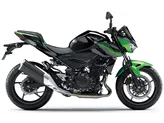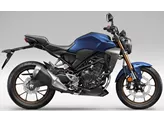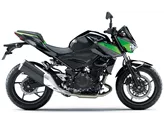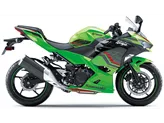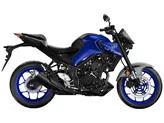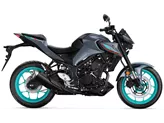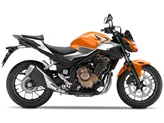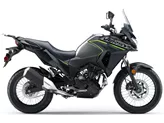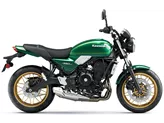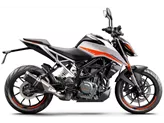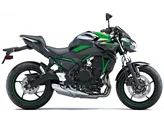Kawasaki Z 300 2015 vs. Kawasaki Z 400 2019

Kawasaki Z 300 2015

Kawasaki Z 400 2019
Overview - Kawasaki Z 300 2015 vs Kawasaki Z 400 2019
The Kawasaki Z 300 model year 2015 and the Kawasaki Z 400 model year 2019 are both naked bikes with similar technical specifications. However, there are some notable differences between the two models.
In terms of engine performance, the Kawasaki Z 400 2019 offers more power with 45 HP compared to the Kawasaki Z 300 2015's 39 HP. The Z 400 also has a higher torque of 38 Nm compared to the Z 300's 27 Nm. Both bikes have a 2-cylinder, liquid-cooled engine, but the Z 400 has a larger displacement of 399 ccm compared to the Z 300's 296 ccm.
Both bikes have a steel frame and double piston front brakes with petal technology. They also have the same front tire width of 110 mm and front tire diameter of 17 inches. However, there are differences in the rear tire width and diameter. The Z 300 has a rear tire width of 140 mm and diameter of 17 inches, while the Z 400 has a wider rear tire with a width of 150 mm and the same diameter of 17 inches.

Kawasaki Z 300 2015
In terms of dimensions and weights, the Z 300 has a longer wheelbase of 1405 mm compared to the Z 400's 1370 mm. Both bikes have the same seat height of 785 mm. The Z 300 has a slightly higher kerb weight of 170 kg with ABS, while the Z 400 is slightly lighter at 167 kg with ABS. The Z 300 also has a larger fuel tank capacity of 17 liters compared to the Z 400's 14 liters.
Now let's discuss the strengths and weaknesses of each model. The Kawasaki Z 300 2015 has an adult look with a high-quality finish. It has a high-revving engine and a comfortable seating position. The brake is stable and the cockpit is easy to read and complete. Additionally, the Z 300 has low fuel consumption, making it an economical choice.

Kawasaki Z 400 2019
On the other hand, the Kawasaki Z 400 2019 has a great and very controllable power delivery. It is lightweight and has a good seating position. The Z 400 also has a great sound, which adds to the overall riding experience. It is particularly suitable for novice riders due to its manageable power.
However, both models have their weaknesses. The Z 300 has a very unobtrusive sound, which may not appeal to riders looking for a more aggressive exhaust note. It also has non-adjustable clutch and brake levers, which may not provide the desired level of customization for some riders. The Z 400, on the other hand, has limited adjustable chassis, which may limit the fine-tuning options for riders seeking a more personalized riding experience.
In conclusion, the Kawasaki Z 400 2019 offers more power and a slightly lighter weight compared to the Kawasaki Z 300 2015. It is also more suitable for novice riders. However, the Z 300 has a larger fuel tank capacity and a more adult look with high-quality finish. Both models have their strengths and weaknesses, so riders should consider their preferences and priorities when choosing between the two.
Technical Specifications Kawasaki Z 300 2015 compared to Kawasaki Z 400 2019
Pros and Cons in comparison
Pros and Cons in comparison
Kawasaki Z 300 2015

The cool design of the Kawasaki Z300, which is extremely similar to that of its big sister Z800, makes it a very grown-up-looking motorbike. The stable braking system and the easy-to-read cockpit with an analogue rev counter and all the necessary features fit in very well with this image. Thanks to the 170 kg ready-to-ride weight, the bike is extremely easy to handle and playful. The engine only reveals its potential in the upper rev range, but revs up willingly and makes you want to ride in a sporty manner. Only the comfort-oriented chassis cannot quite cope with radically sporty demands - but this is quite legitimate and understandable for an entry-level motorbike.
Kawasaki Z 400 2019

The Kawasaki Z400 is definitely a great evolution of its predecessor, the Z300. More power, less weight - all around, simply an even better bike. Above all, the linear power delivery and excellent handling make the Z400 an ideal entry-level bike. The ease of clutch operation and good chassis set-up are also in this vein, which is why the Z400 can be recommended to novice riders without hesitation.
Price Comparison Avarage Market Price Kawasaki Z 300 vs Kawasaki Z 400
There are a few key differences between a Kawasaki Z 300 2015 and a Kawasaki Z 400 2019. It takes less time to sell a Kawasaki Z 400 with 99 days compared to 111 days for the Kawasaki Z 300. Since model year 2015 1000PS.de editors have written 5 reviews for the Kawasaki Z 300 and 8 reviews for the Kawasaki Z 400 since model year 2019. The first review for the Kawasaki Z 300 was published on 04/11/2014 and now has more than 59,800 views. This compares to more than 23,200 views for the first review on Kawasaki Z 400 published on 02/10/2018.


